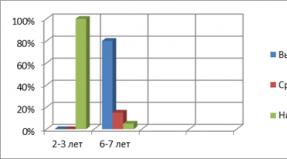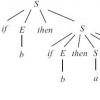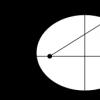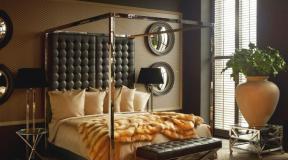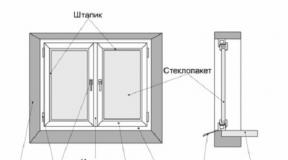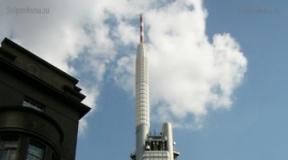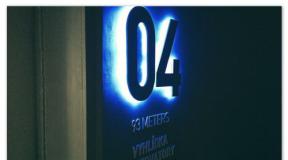The influence of the heating microclimate on the physiological functions of the body. Prevention of overheating of the body. Recommendations for the prevention of overheating and heatstroke Measures for the prevention of overheating and hypothermia of the human body
The fight against the adverse effects of the industrial microclimate is carried out using technological, sanitary-technical and medical-preventive measures.
Technological measures play a leading role in the prevention of the harmful effects of high temperatures of infrared radiation.
Measures aimed at improving the microclimate are regulated by the "Sanitary Rules for the Organization of Technological Processes and Hygienic Requirements for Production Equipment". No. 1042 - 73, section "Production processes and equipment, characterized by the release of heat". Replacing old and introducing new technological processes and equipment contribute to the improvement of unfavorable working conditions. Automation and mechanization of processes, remote control ensure the ability of workers to stay away from the source of radiation and convection heat.
From a hygienic point of view, this group of measures is the most radical. For example, the use of installations for continuous casting of steel and automatic system management of rolled metal contribute to the elimination of heavy operations carried out in conditions of intense infrared radiation.
The main professional groups are operators, whose workplaces are located in specially equipped control posts.
Technological measures include the replacement of ring furnaces with tunnel furnaces in brick, porcelain and earthenware production, when drying molds and cores in foundry, the use of electric furnaces in steel production, the use of stamping instead of forging, induction heating of metals by high-frequency currents.
The group of sanitary measures includes means of localization of heat release and thermal insulation, aimed at reducing the intensity of heat radiation and heat release from equipment.
Heat release into the working area from heated surfaces and steam and gas pipelines is significantly reduced when they are covered with heat-insulating materials (glass wool, asbestos mastic, asbothermite, etc.) - Thermal insulation of the walls of thermal furnaces, which reduces the temperature of their surface from 130 to 80 ° C, reduces heat release by 5 times.
Measures to ensure the tightness of the equipment also contribute to a decrease in heat input to the shop. Tightly fitted doors, dampers, blocking the closing of technological openings with the operation of the equipment - all this significantly reduces the release of heat from open sources. Radiation and convection heat supply to the working area is significantly reduced by using screens, which are divided by the nature of their action into heat-absorbing, heat-removing and heat-reflecting screens. Reflective screens are used to localize heat release from the surface of furnaces, to cover the outer surfaces of control cabins, cranes. Various types of glass are used for heat-absorbing screens: silicate - for protection from sources with a temperature of 700 ° C; organic glass - for protection from a source with a temperature of 900 ° C. These transparent screens are used to protect crane operators of hot shops, operators of control posts from thermal radiation. At open sources of radiation (furnace windows, observation windows of control posts in hot shops), it is advisable to use water screens, since a mirror water curtain reduces the radiation intensity by 5-10 times.
Heat-removing screens, which are hollow steel plates in which water or a water-air mixture circulates, ensure the temperature on the outer surface of the screen does not exceed 30 - 35 ° C. They are installed at the walls of open-hearth, glass-melting furnaces. Heat-shielding metal caisson chambers are used for repair work in hot shops and ladles. To combat infrared radiation of a secondary order (from heated materials, working metal platforms, etc.), it is advisable to use water spraying in the air.
To reduce the air temperature at workplaces in hot shops, rational ventilation plays an important role. Aeration is the most effective means of heat removal, as it provides 40 - 60 times air exchange per hour in the working area. In the presence of heat radiation at the workplaces with an intensity of 348 W / m 2 or more, an air shower is required: In this case, the temperature and speed of movement of the supplied air depend on the season, the category of work and the intensity of thermal radiation.
Air showers increase the release of heat from the human body through convection and evaporation. Air, water-air showers, water half-souls, bases are recommended to be used at the resting places of workers to accelerate the restoration of physiological functions in order to prevent overheating in workers of hot professions. At some workplaces (posts and control panels of rolling mills, cabins of machine cranes), screens cooled to 5 ° C are installed, which enhance heat transfer by radiation (conditions of "radiation cooling" are created).
Personal protective equipment plays a significant role in the prevention of overheating.
Overalls should be breathable and moisture-permeable (cotton, linen; coarse-woolen cloth), have a comfortable cut. For protection from infrared radiation, reflective fabrics are used, on the surface of which a thin layer of metals is sprayed. For work in extreme conditions (extinguishing fires, etc.), special suits are used, which have increased heat output. To protect the head from radiation, use duralumin, fiber helmets, felt hats; for eye protection - glasses (dark or with a transparent layer of metal), masks with a folding screen. When working in the open air at permanent workplaces, awnings, awnings are provided. The cabins of the cars are painted in light colors, equipped with air conditioners, and thermally insulated.
Organizational and medical preventive measures. An important factor contributing to the increase in the efficiency of workers in hot shops is a rational work and rest regime.
The working regime is developed in relation to specific working conditions. In this case, the total duration of rest during the working day, the duration of individual rest periods is determined. Frequent short breaks are more effective in maintaining performance than infrequent but long breaks.
For work performed on open sites in the southern regions, work and rest regimes are developed, taking into account the time of the greatest insolation.
In hot climates, it is suggested to start the working day earlier, and in the hottest hours (from 12 to 18 hours) to take breaks.
Rational modes of work and rest have been developed for builders working in various climatic zones of the country.
During physical work moderate and an outside air temperature of up to 25 ° C, the in-shift mode provides for 10-minute breaks after 60 - 50 minutes of work; at an outside air temperature of 25 to 33 ° C, 15-minute breaks are recommended after 45 minutes of work and a break of the work shift by 4 - 5 hours for the hottest period.
High hygienic efficiency of rest rooms with artificial cooling of panels. Staying in this room for workers during short breaks results in faster recovery of physiological functions than in conventional rest rooms without refrigeration.
For short-term work in high temperature conditions (extinguishing underground fires, repairing metallurgical furnaces), where the temperature is 80 - 100 ° C, heat training is of great importance.
Resistance to high temperatures can be increased to some extent using pharmacological agents (taking dibazol, ascorbic acid, a mixture of these substances and glucose), inhalation of oxygen, and aeroionization.
Drinking regime is essential for the prevention of overheating. In hot shops, when performing physical work, in conditions of prolonged (50% or more) infrared irradiation, when moisture loss exceeds 3.5 - 5 liters per shift, cooled (up to 15 - 20 ° C), salted (0.5% sodium chloride solution) carbonated water with the addition of potassium salts, water-soluble vitamins... With less moisture loss, salt consumption is replenished through food intake. In the southern regions of the country, instead of salted water, they use protein-vitamin drinks, fortified green long tea, yandak - tea containing mineral salts, trace elements, vitamins. These drinks have a tonic effect on the body and replenish the loss of vitamins and salts. By the decree of the Council of Ministers of the USSR and the Presidium of the Central Council of Trade Unions of 10.02.61, No. 122/3, workers of the hot shops of metallurgical plants are provided with vitamins A, B1, B2, C and PP free of charge every day.
In accordance with the order of the Ministry of Health of the USSR No. 700 of 19.06.84, workers and employees undergo preliminary and periodic medical examinations once every 24 months.
Contraindications to hiring in conditions of high temperature and infrared radiation are organic diseases of the cardiovascular system, kidneys, stomach, skin, disorders of ovarian-menstrual function.
Measures to prevent the adverse effects of cold should provide for heat retention - prevention of cooling of industrial premises, selection of rational modes of work and rest, use of personal protective equipment and measures to increase the body's defenses.
Sanitary standards regulate the device of gates, openings - air curtains, airlocks, double glazing of windows, thermal insulation of floors and walls are used. In large workshops at workplaces, the microclimate is maintained by local heating - air or radiation (local radiant).
For non-fixed workplaces (work in refrigerators) and work in the open air in cold climatic zones, special rooms for heating are organized. They can be stationary or mobile - container type. The temperature in them is maintained at 21 - 23 ° С and special devices are provided for the rapid heating of the upper and lower limbs(local radiant-contact heating 696 - 1044 W / m 2). A floor heating system is also used with heating mats made of graphite carbon fabric. On separate open areas (construction works, construction of roads, bridges), local radiant heating from electrical sources is installed, providing a constant radiation intensity regardless of the strength of the wind.
In the fight against cooling, a rational mode of work and rest is very important. It helps to strengthen the dynamic stereotype, prevents premature fatigue, increases the period of sustainable performance, and increases labor productivity. When working in the open air during the cold season (below 10 ° C), the mode of work and rest is set depending on the parameters of the outside air, and in the North - also on the severity of the weather. The severity of the weather is determined by the temperature and speed of air movement - an increase in air speed by 1 m / s corresponds to a decrease in air temperature by 2 ° C. The cessation of outdoor work at low temperatures is carried out on the basis of a resolution of the local councils. Under unfavorable meteorological conditions - air temperature - 10 ° C and below - heating breaks of 10-15 minutes are required every hour. When the outside air temperature is between -30 and -45 ° C, 15-minute rest breaks are organized after 60 minutes. from the beginning of the work shift and after lunch, and then after every 45 minutes of work.
In rooms for heating, it is necessary to provide for the possibility of drinking hot tea. It is rational to equip these rooms with dry-air showers, which increase the heating effect by 4-6 times. After working in refrigerated chambers, it is advisable to take a water shower of 38 - 40 ° C.
Personal protective equipment is essential in preventing body cooling. Clothing materials must have good heat-shielding properties (fur, wool, sheepskin, cotton wool, synthetic fur). When working in extreme temperatures, it is recommended to use multi-layer and electrically heated clothing.
It should be borne in mind that wet, contaminated overalls lose their protective properties, therefore, household premises should be equipped with dryers and cleaning devices.
In order to prevent cooling and increase resistance to the effects of cold, it is recommended to harden the body by carrying out hydro-procedures, air and sun baths, to increase the body's resistance with the help of UV irradiation, physical exercises.
Medical contraindications for working in cold conditions are diseases of the endocrine glands, metabolic diseases, hematopoietic organs, chronic diseases of the respiratory tract, kidneys, peripheral vessels, joints, etc.
Industrial sanitation and occupational health
The influence of the heating microclimate on the physiological functions of the body. Prevention of overheating of the body.
Human life can proceed normally only if the body's temperature homeostasis is maintained, which is achieved due to the thermoregulation system and the activity of other functional systems: cardiovascular, excretory, endocrine and systems that provide energy, water-salt and protein metabolism. To maintain a constant body temperature, the body must be in a thermostable state, which is assessed by the heat balance. Heat balance is achieved by coordinating the processes of heat production and heat transfer.
High air temperature contributes to the rapid fatigue of the worker, can lead to overheating of the body, heatstroke. A heating microclimate can lead to a general illness, which manifests itself most often in the form of thermal collapse. It occurs due to the expansion of blood vessels and a decrease in blood pressure in them. At the same time, the body temperature is not too high. Fainting preceded headache, feeling of weakness, dizziness, nausea. The skin first turns red, then turns pale and covered with cold sweat. The heart rate increases. This condition resolves quickly when resting in a cool place. The intense sweating arising under these conditions is accompanied by the loss of salts and water in the body. The number of platelets in the blood and its viscosity increase, as well as the level of cholesterol in the blood plasma, which increases the likelihood of thrombosis (in particular, of the cerebral arteries). The incidence among workers in hot shops is 1.2 - 2.1 times higher than among workers who are not exposed to a constant heating microclimate. Thermal stress in the main shops of metallurgical production accounts for 37% of all respiratory diseases and 39% of diseases of the digestive system. Diseases occur of cardio-vascular system associated with significant stress hemodynamics, manifested in the form of persistent myocardiopathies, neurocirculatory dystonia of the hypertensive type. Intensive biological aging of workers occurs, whose work is associated with significant heat and physical activity, especially in the age group from 50 years old. Headaches, excessive sweating and fatigue are observed. A significant increase in standardized mortality rates from diseases of the cardiovascular system was revealed.
As a result of sunstroke, first of all, the functions of the brain are disrupted due to local overheating of the head unprotected from the sun. Depletion of moisture in the body can lead to heat exhaustion. A decrease in the moisture content in the human body by 1 - 2% of the total mass does not lead to any significant changes in the body (except for the feeling of thirst). With increasing dehydration of the body, such phenomena as drowsiness, uncoordinated movements and a significant decrease in working capacity occur. With a moisture deficit of more than 10% of the body weight, loss of consciousness occurs, sometimes - a state of intense excitement and death.
Cooling microclimate is a combination of parameters in which the total heat transfer to the environment exceeds the amount of heat production of the body. This leads to the formation of a general and (or) local heat deficit in the human body (> 2 W).
A heating microclimate is a combination of parameters in which there is a change in heat exchange between a person and the environment, which manifests itself in the accumulation of heat in the body (> 2 W) and (or) in an increase in the proportion of heat loss by evaporation of moisture (> 30%).
The microclimate in industrial premises is formed under the influence of the following factors:
The presence of sources of heat generation (including working personnel);
Heat input from solar radiation;
Heat generation during the operation of electrical equipment;
The air exchange rate in the room;
Heat transfer through enclosing structures;
Surface temperatures of equipment and enclosing structures.
P.'s prevention of the lake. includes a set of measures aimed at protecting workers from heat sources, organizing a rational daily routine, medical supervision for working people, drinking regimen and nutrition. Water intake should be sufficient to quench thirst; fractional water intake is considered the most appropriate. With a loss of more than 4-4.5 Kg body weight per work shift, an additional intake of table salt is recommended. For those working in high temperatures, it is desirable to limit the intake of fatty foods, reduce the calorie content of lunch, increasing the calorie content of dinner and breakfast: carbohydrate and carbohydrate-protein foods are preferable. To protect against the adverse effects of high temperatures, those working in the open air periodically need a short-term rest in places protected from direct sunlight, close to the place of work (under a canopy, awning, in a portable house or camper, which are equipped with fans, air conditioners, showers). Workers must be provided with sufficient drinking water, fortified drinks, as well as breathable and vapor-permeable overalls and headgear. It is advisable to plan outdoor work for cool morning and evening hours, and the hottest time should be reserved for rest and work in cool rooms. For P.'s prevention of the lake. In high temperature industrial environments, water spraying and air blasting is recommended. Rest rooms should be equipped with air conditioning, cooling and / or ventilation systems.
2. Electromagnetic fields. Sources. Methods and means of protection.
Electromagnetic fields
In practice, when characterizing the electromagnetic environment, the terms "electric field", "magnetic field", "electromagnetic field" are used. Let us briefly explain what this means and what connection exists between them. The electric field is created by charges. For example, in all the well-known school experiments on the electrification of ebonite, there is just an electric field.
A magnetic field is created when electric charges move along a conductor. To characterize the magnitude of the electric field, the concept of electric field strength is used, the designation E, the unit of measurement is V / m (Volt-per-meter). The magnitude of the magnetic field is characterized by the strength of the magnetic field H, unit A / m (Ampere per meter). When measuring ultra-low and extremely low frequencies, the concept of magnetic induction B is also often used, a unit of T (Tesla), one millionth of a T corresponds to 1.25 A / m.
By definition, an electromagnetic field is a special form of matter through which an action is carried out between electrically charged particles. The physical reasons for the existence of an electromagnetic field are associated with the fact that a time-varying electric field E generates a magnetic field H, and a changing H - a vortex electric field: both components E and H, continuously changing, excite each other. The EMF of stationary or uniformly moving charged particles is inextricably linked with these particles. With the accelerated motion of charged particles, the EMF "breaks away" from them and exists independently in the form of electromagnetic waves, without disappearing with the removal of the source (for example, radio waves do not disappear even in the absence of current in the antenna that emitted them).
Electromagnetic waves are characterized by their wavelength, symbol l (lambda). The source that generates radiation, and in fact creates electromagnetic oscillations, are characterized by frequency, designation - f. An important feature of the EMF is its division into the so-called "near" and far zones. In the "near" zone, or the induction zone, at a distance from the source r< l ЭМП можно считать квазистатическим. Здесь оно быстро убывает с расстоянием, обратно пропорционально квадрату r -2 или кубу r -3 расстояния. В "ближней" зоне излучения электромагнитная волне еще не сформирована. Для характеристики ЭМП измерения переменного электрического поля Е и переменного магнитного поля Н производятся раздельно. Поле в зоне индукции служит для формирования бегущих составляющей полей (электромагнитной волны), ответственных за излучение. "Дальняя" зона - это зона сформировавшейся электромагнитной волны, начинается с расстояния r >3l. In the "far" zone, the field intensity decreases in inverse proportion to the distance to the source r -1.
In the "far" radiation zone there is a connection between E and H: E = 377H, where 377 is the characteristic impedance of vacuum, Ohm. Therefore, as a rule, only E is measured. In Russia, at frequencies above 300 MHz, the electromagnetic energy flux density (PES), or the Poyting vector, is usually measured. Designated as S, the unit is W / m2. PES characterizes the amount of energy carried by an electromagnetic wave per unit of time through a unit of surface perpendicular to the direction of wave propagation.
2. Effects on the human body
In the USSR, extensive studies of electromagnetic fields began in the 1960s. A large amount of clinical material was accumulated on the unfavorable effect of magnetic and electromagnetic fields, it was proposed to introduce a new nosological disease "Radio wave sickness" or "Chronic damage by microwaves". Later, by the work of scientists in Russia, it was established that, firstly, the human nervous system, especially higher nervous activity, is sensitive to EMF, and, secondly, that EMF possesses the so-called. informational action when exposed to a person in intensities below the threshold value of the thermal effect. The results of these works were used in the development of regulatory documents in Russia. As a result, the standards in Russia were set very strict and differed from the American and European ones by several thousand times (for example, in Russia, the remote control for professionals is 0.01 mW / cm2; in the USA - 10 mW / cm2).
Biological action of electromagnetic fields
Experimental data of both domestic and foreign researchers indicate a high biological activity of EMF in all frequency ranges. With relatively high levels of the irradiating EMF, the modern theory recognizes the thermal mechanism of action. With a relatively low level of EMF (for example, for radio frequencies above 300 MHz, this is less than 1 mW / cm2), it is customary to talk about a non-thermal or informational nature of the effect on the body. The mechanisms of action of EMF in this case are still poorly understood. Numerous studies in the field of the biological effect of EmFs will make it possible to determine the most sensitive systems of the human body: nervous, immune, endocrine and reproductive. These body systems are critical. The reactions of these systems must be taken into account when assessing the risk of exposure to EMF on the population. Biological effect EmF under conditions of long-term exposure accumulates, as a result, the development of long-term consequences, including degenerative processes of the central nervous system, blood cancer (leukemia), brain tumors, hormonal diseases. EMF can be especially dangerous for children, pregnant women (embryos), people with diseases of the central nervous, hormonal, cardiovascular systems, allergy sufferers, people with weakened immunity.
Effects on the nervous system
A large number of studies carried out in Russia and the monographic generalizations made give grounds to classify the nervous system as one of the most sensitive systems in the human body to the effects of EMF. At the level of the nerve cell, structural formations for transmission nerve impulses(synapse), at the level of isolated nerve structures, significant deviations occur when exposed to low-intensity EMF. Higher nervous activity and memory change in people who have contact with EMF. These individuals may be prone to developing stressful reactions. Certain structures of the brain are hypersensitive to EMF. Changes in the permeability of the blood-brain barrier can lead to unexpected adverse effects. The nervous system of the embryo is especially sensitive to EMF.
Influence at immune system
At the present time, enough data has been accumulated indicating bad influence EMF on the body's immunological reactivity. The results of research by Russian scientists give reason to believe that when exposed to EMF, the processes of immunogenesis are disrupted, more often in the direction of their oppression. It was also found that in animals irradiated with EMF, the nature of the infectious process changes - the course of the infectious process is aggravated. The emergence of autoimmunity is associated not so much with a change in the antigenic structure of tissues, but with a pathology of the immune system, as a result of which it reacts against normal tissue antigens. In line with this concept. the basis of all autoimmune conditions is primarily immunodeficiency in thymus-dependent cell population of lymphocytes. The effect of high-intensity EMF on the body's immune system is manifested in a depressing effect on the T-system of cellular immunity. EMFs can promote nonspecific suppression of immunogenesis, enhance the formation of antibodies to fetal tissues, and stimulate an autoimmune response in the body of a pregnant female.
Influence at endocrine system and neurohumoral response
In the works of Russian scientists back in the 60s, in the interpretation of the mechanism of functional disorders under the influence of EMF, the leading place was given to changes in the pituitary adrenal system. Studies have shown that under the action of EMF, as a rule, there was stimulation of the pituitary-adrenaline system, which was accompanied by an increase in the content of adrenaline in the blood, activation of blood coagulation processes. It was recognized that one of the systems that early and naturally involves the body's response to the effects of various environmental factors is the hypothalamus-pituitary-adrenal cortex system. Research results have confirmed this position.
Impact on sexual function
Sexual dysfunction is usually associated with a change in its regulation by the nervous and neuroendocrine systems. This is related to the results of work on the study of the state of the gonadotropic activity of the pituitary gland under the influence of EMF. Repeated exposure to EMF causes a decrease in the activity of the pituitary gland
Any environmental factor affecting female body during pregnancy and affecting embryonic development, is considered teratogenic. Many scientists attribute EMF to this group of factors.
Of primary importance in studies of teratogenesis is the stage of pregnancy during which EMF is exposed. It is generally accepted that EMFs can, for example, cause deformities by acting at different stages of pregnancy. Although there are periods of maximum sensitivity to EMF. The most vulnerable periods are usually early stages development of the embryo, corresponding to the periods of implantation and early organogenesis.
An opinion was expressed about the possibility of a specific effect of EMF on the sexual function of women, on the embryo. A higher sensitivity to the effects of EMF of the ovaries than of the testes was noted. It has been established that the sensitivity of the embryo to EMF is significantly higher than the sensitivity of the maternal organism, and intrauterine damage to the fetus by EMF can occur at any stage of its development. The results of the conducted epidemiological studies will lead to the conclusion that the presence of women in contact with electromagnetic radiation can lead to premature birth, affect the development of the fetus and, finally, increase the risk of developing congenital malformations.
Other biomedical effects
Since the beginning of the 60s, extensive research has been carried out in the USSR to study the health of people who have contact with EMF at work. results clinical research showed that prolonged contact with EMF in the microwave range can lead to the development of diseases, clinical picture which is determined, first of all, by changes in the functional state of the nervous and cardiovascular systems. It was proposed to isolate an independent disease - radio wave disease. This disease, according to the authors, can have three syndromes as the severity of the disease increases:
· Asthenic syndrome;
· Asthenic-vegetative syndrome;
Hypothalamic syndrome.
The earliest clinical manifestations the consequences of exposure to EM radiation on humans are functional disorders from the nervous system, manifested primarily in the form of autonomic dysfunctions of neurasthenic and asthenic syndrome. Persons who have been in the EM radiation zone for a long time complain of weakness, irritability, rapid fatigue, memory impairment, and sleep disturbance. Often, these symptoms are joined by disorders of autonomic functions. Disturbances from the cardiovascular system are manifested, as a rule, by neurocirculatory dystonia: pulse lability and blood pressure, a tendency to hypotension, pain in the region of the heart, etc. There are also phase changes in the composition of peripheral blood (lability of indicators) with the subsequent development of moderate leukopenia, neuropenia, erythrocytopenia. Changes bone marrow are in the nature of reactive compensatory regeneration voltage. Usually, these changes occur in persons, by the nature of their work, who were constantly under the influence of EM radiation with a sufficiently high intensity. Those working with MP and EMF, as well as the population living in the area of EMF operation, complain of irritability and impatience. After 1-3 years, some have a feeling of inner tension, fussiness. Attention and memory are impaired. There are complaints about low sleep efficiency and fatigue. Given the important role of the cerebral cortex and hypothalamus in the implementation of human mental functions, it can be expected that prolonged repeated exposure to the maximum permissible EM radiation (especially in the decimeter wavelength range) may lead to mental disorders.
3. Methods and means of protection
Organizational measures for protection against EMF Organizational measures for protection against EMF include: selection of operating modes of emitting equipment that provides a radiation level that does not exceed the maximum permissible level, limitation of the place and time spent in the area of EMF action (protection by distance and time), designation and fencing zones with elevated level EMF.
Time protection is applied when it is not possible to reduce the radiation intensity at a given point to the maximum acceptable level... The operating remote controls provide for a relationship between the intensity of the energy flux density and the exposure time.
Distance protection is based on the drop in radiation intensity, which is inversely proportional to the square of the distance and is used if it is impossible to weaken the EMF by other measures, including time protection. Distance protection is the basis for radiation rationing zones to determine the necessary gap between EMF sources and residential buildings, office premises, etc. For each installation emitting electromagnetic energy, sanitary protection zones must be determined in which the intensity of the EMF exceeds the MPL. The boundaries of the zones are determined by calculation for each specific case of the placement of the emitting installation when they operate at the maximum radiation power and are monitored with the help of instruments. In accordance with GOST 12.1.026-80, the radiation zones are fenced off or installed with warning signs with the words: "Do not enter, it is dangerous!"
Engineering and technical measures to protect the population from EMF
Engineering and technical protective measures are based on the use of the phenomenon of shielding of electromagnetic fields directly at the places where a person is staying or at measures to limit the emission parameters of the field source. The latter, as a rule, is applied at the stage of development of a product that serves as a source of EMF. Radio emissions can penetrate into rooms where people are through window and door openings. For the shielding of observation windows, windows of premises, glazing of ceiling lamps, partitions, metallized glass is used, which has shielding properties. This property is given to glass by a thin transparent film of either metal oxides, most often tin, or metals - copper, nickel, silver, and their combinations. The film has sufficient optical transparency and chemical resistance. When applied to one side of the glass surface, it attenuates the radiation intensity in the range of 0.8 - 150 cm by 30 dB (1000 times). When the film is applied to both glass surfaces, the attenuation reaches 40 dB (10,000 times).
To protect the population from the effects of electromagnetic radiation in building structures, a metal mesh, metal sheet or any other conductive coating, including specially designed building materials, can be used as protective screens. In some cases, it is sufficient to use a grounded metal mesh placed under the facing or plaster layer. Various films and fabrics with a metallized coating can also be used as screens. In recent years, metallized fabrics based on synthetic fibers have been obtained as radio-shielding materials. They are obtained by the method of chemical metallization (from solutions) of tissues of various structures and densities. Existing methods of obtaining allows you to adjust the amount of applied metal in the range from hundredths to a few microns and change the surface resistivity of tissues from tens to fractions of ohms. Shielding textile materials have small thickness, lightness, flexibility; they can be duplicated by other materials (fabrics, leather, films), they are well combined with resins and latexes.
3. Prevention of overheating and hypothermia
3.1 In order to prevent overheating of workers at an air temperature above the permissible values, the time spent at these workplaces should be limited to the values indicated in table. 9, while the average shift air temperature should not go beyond the permissible values of air temperature for the relevant categories of work, established by sanitary rules and standards for hygienic requirements for the microclimate of industrial premises.
Overheating of an employee is allowed above the permissible level when regulating periods of continuous stay at the workplace and periods of rest in conditions of thermal comfort. At an air temperature of 50 - 40 ° C, no more than three times a stay is allowed per working shift of the specified duration.
The time of continuous stay at the workplace, indicated in Table 9 for persons who are not adapted to the heating microclimate (newly hired, temporarily interrupted work due to vacation, illness, etc.), is reduced by 5 minutes, and the duration of rest is increased by 5 minutes.
When working in special protective clothing, the materials of which are air- and moisture-proof, the air temperature (Table 9) decreases at the rate of 1.0 ° C for every 10% of the body surface excluded from heat and mass transfer.
Workers exposed to heat irradiation, depending on its intensity, are provided with appropriate overalls with a positive sanitary and epidemiological conclusion.
The collective protective equipment used must meet the requirements of the current regulatory documents for collective protection against infrared radiation (IR radiation).
In order to reduce the heat load on workers, it is allowed to use air spraying.
For an integral assessment of the thermal load of the environment, due to a complex of factors (air temperature, speed of its movement, relative humidity, thermal radiation), it is necessary to use the index of the thermal load of the environment (THC-index), the values of which, taking into account the level of energy consumption and the duration of exposure during the work shift are shown in Table 6.
Prevention of violation water balance workers in a heating microclimate contributes to the provision of complete replacement of liquid, various salts, microelements (magnesium, copper, zinc, iodine, etc.), water-soluble vitamins excreted from the body with sweat.
For optimal water supply to workers, it is advisable to place drinking water supply devices (carbonated water installations, saturators, drinking fountains, cisterns, etc.) as close as possible to workplaces, providing free access to them.
To replenish the liquid deficit, it is advisable to provide for the issuance of tea, mineral alkaline water, cranberry fruit drink, lactic acid drinks (skim milk, buttermilk, whey), dried fruit decoctions to workers, subject to sanitary standards and rules for their production, storage and sale.
To increase the efficiency of compensating for the deficiency of vitamins, salts, microelements, the drinks used should be changed. You should not limit employees in the total amount of fluid consumed, but the volume of a single intake is regulated (one glass). The most optimal is the temperature of the liquid, equal to
3.2 Those working in an open area during the cold season are provided with a set of personal protective equipment (PPE) from the cold, taking into account the climatic region (zone). At the same time, a set of PPE must have a positive sanitary and epidemiological conclusion indicating the value of its thermal insulation.
In order to avoid local cooling, workers should be provided with mittens, shoes, and hats in relation to a specific climatic region (belt). For mittens, shoes, hats, there must be positive sanitary and epidemiological conclusions indicating the values of their thermal insulation.
When developing an in-shift mode of operation, one should focus on the permissible degree of cooling of workers, regulated by the time of continuous stay in the cold and the time of heating in order to normalize the thermal state of the body.
In order to normalize the thermal state of the employee, the air temperature in the heating places is maintained at the level of 21 - 25 ° C. The room should also be equipped with devices, the temperature of which should not be higher than 40 ° C (35 - 40 ° C), for heating the hands and feet.
The duration of the first rest period is allowed to be limited to 10 minutes, the duration of each subsequent one should be increased by 5 minutes.
In order to more quickly normalize the thermal state and lower the rate of cooling of the body during the subsequent period of stay in the cold, outer insulated clothing should be removed in the heating room.
To avoid hypothermia, employees should not be in the cold (in an open area) during breaks in work for more than 10 minutes at an air temperature of up to -10 ° C and no more than 5 minutes at an air temperature below -10 ° C.
Heating breaks can be combined with breaks to restore the functional state of the employee after performing physical work. During the lunch break, the employee is provided with "hot" meals. You should start working in the cold no earlier than 10 minutes after taking "hot" food (tea, etc.).


0.3-0.7 Not more than 1, but not less than 0.5 Not more than 3 "C above the average outdoor temperature at 13:00 of the hottest month. Same 3. Protection from abnormal meteorological conditions. thermal equilibrium between the body and the environment Maintaining the parameters that determine the microclimate at a given level ...
All studies and analyzes were carried out on the plants and grain mass of the Maria variety forage beans. This variety is the most promising for the cultivation of forage beans in the forest-steppe zone of the Chelyabinsk region. Included in the State Register for the 9th Ural Region Russian Federation... Plant of medium height, semi-determinant type of development. The flower is long. The sail of the flower has a melanin ...
The fight against the adverse effects of the industrial microclimate is carried out using technological, sanitary-technical and medical-preventive measures.
Technological measures play a leading role in the prevention of the harmful effects of high temperatures of infrared radiation.
Measures aimed at improving the microclimate are regulated by the "Sanitary Rules for the Organization of Technological Processes and Hygienic Requirements for Production Equipment". No. 1042 - 73, section "Production processes and equipment, characterized by the release of heat". Replacing old and introducing new technological processes and equipment contribute to the improvement of unfavorable working conditions. Automation and mechanization of processes, remote control ensure the ability of workers to stay away from the source of radiation and convection heat.
From a hygienic point of view, this group of measures is the most radical. For example, the use of continuous casting plants and an automatic control system for rolled metal help to eliminate difficult operations carried out in conditions of intense infrared radiation.
The main professional groups are operators, whose workplaces are located in specially equipped control posts.
Technological measures include the replacement of ring furnaces with tunnel furnaces in brick, porcelain and earthenware production, when drying molds and cores in foundry, the use of electric furnaces in steel production, the use of stamping instead of forging, induction heating of metals by high-frequency currents.
The group of sanitary measures includes means of localization of heat release and thermal insulation, aimed at reducing the intensity of heat radiation and heat release from equipment.
Heat release into the working area from heated surfaces and steam and gas pipelines is significantly reduced when they are covered with heat-insulating materials (glass wool, asbestos mastic, asbothermite, etc.) - Thermal insulation of the walls of thermal furnaces, which reduces the temperature of their surface from 130 to 80 ° C, reduces heat release by 5 times.
Measures to ensure the tightness of the equipment also contribute to a decrease in heat input to the shop. Tightly fitted doors, dampers, blocking the closing of technological openings with the operation of the equipment - all this significantly reduces the release of heat from open sources. Radiation and convection heat supply to the working area is significantly reduced by using screens, which are divided by the nature of their action into heat-absorbing, heat-removing and heat-reflecting screens. Reflective screens are used to localize heat release from the surface of furnaces, to cover the outer surfaces of control cabins, cranes. Various types of glass are used for heat-absorbing screens: silicate - for protection from sources with a temperature of 700 ° C; organic glass - for protection from a source with a temperature of 900 ° C. These transparent screens are used to protect crane operators of hot shops, operators of control posts from thermal radiation. At open sources of radiation (furnace windows, observation windows of control posts in hot shops), it is advisable to use water screens, since a mirror water curtain reduces the radiation intensity by 5-10 times.
Heat-removing screens, which are hollow steel plates in which water or a water-air mixture circulates, ensure the temperature on the outer surface of the screen does not exceed 30 - 35 ° C. They are installed at the walls of open-hearth, glass-melting furnaces. Heat-shielding metal caisson chambers are used for repair work in hot shops and ladles. To combat infrared radiation of a secondary order (from heated materials, working metal platforms, etc.), it is advisable to use water spraying in the air.
To reduce the air temperature at workplaces in hot shops, rational ventilation plays an important role. Aeration is the most effective means of heat removal, as it provides 40 - 60 times air exchange per hour in the working area. In the presence of heat radiation at the workplaces with an intensity of 348 W / m 2 or more, an air shower is required: In this case, the temperature and speed of movement of the supplied air depend on the season, the category of work and the intensity of thermal radiation.
Air showers increase the release of heat from the human body through convection and evaporation. Air, water-air showers, water half-souls, bases are recommended to be used at the resting places of workers to accelerate the restoration of physiological functions in order to prevent overheating in workers of hot professions. At some workplaces (posts and control panels of rolling mills, cabins of machine cranes), screens cooled to 5 ° C are installed, which enhance heat transfer by radiation (conditions of "radiation cooling" are created).
Personal protective equipment plays a significant role in the prevention of overheating.
Overalls should be breathable and moisture-permeable (cotton, linen; coarse-woolen cloth), have a comfortable cut. For protection from infrared radiation, reflective fabrics are used, on the surface of which a thin layer of metals is sprayed. For work in extreme conditions (extinguishing fires, etc.), special suits are used, which have increased heat output. To protect the head from radiation, use duralumin, fiber helmets, felt hats; for eye protection - glasses (dark or with a transparent layer of metal), masks with a folding screen. When working in the open air at permanent workplaces, awnings, awnings are provided. The cabins of the cars are painted in light colors, equipped with air conditioners, and thermally insulated.
Organizational and medical preventive measures. An important factor contributing to the increase in the efficiency of workers in hot shops is a rational work and rest regime.
The working regime is developed in relation to specific working conditions. In this case, the total duration of rest during the working day, the duration of individual rest periods is determined. Frequent short breaks are more effective in maintaining performance than infrequent but long breaks.
For work performed on open sites in the southern regions, work and rest regimes are developed, taking into account the time of the greatest insolation.
In hot climates, it is suggested to start the working day earlier, and in the hottest hours (from 12 to 18 hours) to take breaks.
Rational modes of work and rest have been developed for builders working in various climatic zones of the country.
For physical work of medium severity and an outside air temperature of up to 25 ° C, the in-shift mode provides for 10-minute breaks after 60 - 50 minutes of work; at an outside air temperature of 25 to 33 ° C, 15-minute breaks are recommended after 45 minutes of work and a break of the work shift by 4 - 5 hours for the hottest period.
High hygienic efficiency of rest rooms with artificial cooling of panels. Staying in this room for workers during short breaks results in faster recovery of physiological functions than in conventional rest rooms without refrigeration.
For short-term work in high temperature conditions (extinguishing underground fires, repairing metallurgical furnaces), where the temperature is 80 - 100 ° C, heat training is of great importance.
Resistance to high temperatures can be increased to some extent using pharmacological agents (taking dibazol, ascorbic acid, a mixture of these substances and glucose), inhalation of oxygen, and aeroionization.
Drinking regime is essential for the prevention of overheating. In hot shops, when performing physical work, in conditions of prolonged (50% or more) infrared irradiation, when moisture loss exceeds 3.5 - 5 liters per shift, cooled (up to 15 - 20 ° C), salted (0.5% sodium chloride solution) carbonated water with the addition of potassium salts, water-soluble vitamins. With less moisture loss, salt consumption is replenished through food intake. In the southern regions of the country, instead of salted water, they use protein-vitamin drinks, fortified green long tea, yandak - tea containing mineral salts, trace elements, vitamins. These drinks have a tonic effect on the body and replenish the loss of vitamins and salts. By the decree of the Council of Ministers of the USSR and the Presidium of the Central Council of Trade Unions of 10.02.61, No. 122/3, workers of the hot shops of metallurgical plants are provided with vitamins A, B1, B2, C and PP free of charge every day.
In accordance with the order of the Ministry of Health of the USSR No. 700 of 19.06.84, workers and employees undergo preliminary and periodic medical examinations once every 24 months.
Contraindications to hiring in conditions of high temperature and infrared radiation are organic diseases of the cardiovascular system, kidneys, stomach, skin, disorders of ovarian-menstrual function.
Measures to prevent the adverse effects of cold should provide for heat retention - prevention of cooling of industrial premises, selection of rational modes of work and rest, use of personal protective equipment and measures to increase the body's defenses.
Sanitary standards regulate the device of gates, openings - air curtains, airlocks, double glazing of windows, thermal insulation of floors and walls are used. In large workshops at workplaces, the microclimate is maintained by local heating - air or radiation (local radiant).
For non-fixed workplaces (work in refrigerators) and work in the open air in cold climatic zones, special rooms for heating are organized. They can be stationary or mobile - container type. The temperature in them is maintained at 21 - 23 ° C and special devices are provided for rapid heating of the upper and lower extremities (local radiant-contact heating 696 - 1044 W / m 2). A floor heating system is also used with heating mats made of graphite carbon fabric. On separate open areas (construction works, construction of roads, bridges), local radiant heating from electrical sources is installed, providing a constant radiation intensity regardless of the strength of the wind.
In the fight against cooling, a rational mode of work and rest is very important. It helps to strengthen the dynamic stereotype, prevents premature fatigue, increases the period of sustainable performance, and increases labor productivity. When working in the open air during the cold season (below 10 ° C), the mode of work and rest is set depending on the parameters of the outside air, and in the North - also on the severity of the weather. The severity of the weather is determined by the temperature and speed of air movement - an increase in air speed by 1 m / s corresponds to a decrease in air temperature by 2 ° C. The cessation of outdoor work at low temperatures is carried out on the basis of a resolution of the local councils. Under unfavorable meteorological conditions - air temperature - 10 ° C and below - heating breaks of 10-15 minutes are required every hour. When the outside air temperature is between -30 and -45 ° C, 15-minute rest breaks are organized after 60 minutes. from the beginning of the work shift and after lunch, and then after every 45 minutes of work.
In rooms for heating, it is necessary to provide for the possibility of drinking hot tea. It is rational to equip these rooms with dry-air showers, which increase the heating effect by 4-6 times. After working in refrigerated chambers, it is advisable to take a water shower of 38 - 40 ° C.
Personal protective equipment is essential in preventing body cooling. Clothing materials must have good heat-shielding properties (fur, wool, sheepskin, cotton wool, synthetic fur). When working in extreme temperatures, it is recommended to use multi-layer and electrically heated clothing.
It should be borne in mind that wet, contaminated overalls lose their protective properties, therefore, household premises should be equipped with dryers and cleaning devices.
In order to prevent cooling and increase resistance to the effects of cold, it is recommended to harden the body by carrying out hydro-procedures, air and sun baths, to increase the body's resistance with the help of UV irradiation, physical exercises.
Medical contraindications for working in cold conditions are diseases of the endocrine glands, metabolic diseases, hematopoietic organs, chronic diseases of the respiratory tract, kidneys, peripheral vessels, joints, etc.
Prevention of overheating of the body is carried out by limiting the flow of heat into the premises and its impact on workers, effective ways ventilation, rationalization of work and rest regimes, drinking regime, clothing.
Mechanization of labor processes and the use of more advanced types of equipment reduce the flow of heat into the working area. Examples are the use of electric furnaces in steelmaking, machine forging of metal instead of manual forging, mechanized loading of furnaces in metallurgy, loading of products into and out of drying chambers, and cooling of hot products in separate rooms. Mechanization of work, making it easier, reduces energy consumption, thereby reducing the possibility of overheating the body.
Remote control of the work process increases the distance between the worker and the heat source, which reduces the intensity of radiation affecting a person. Removal of equipment to open areas in the chemical and other industries in some cases also leads to a decrease in heat generation in workshops and overheating of the body.
In removing excess heat from the room, rational ventilation - mechanical and especially natural (aeration) - plays an important role in the prevention of overheating of the body. To create normal, air showers and oases are arranged in individual workplaces and zones. Air conditioning is widely used in a number of industries.
Rationalization of work and rest regimes is carried out by shortening the working day, introducing additional breaks, creating conditions for effective rest. In our country, a 6-hour working day is established for many professions in "hot" shops. In summer, it is advisable to start work in the early hours, and in case of multi-shift work, the hot period (from 12 to 16 hours) must be evenly distributed between shifts. The frequency and duration of additional (except for lunch) breaks are established on the basis of physiological studies. They should have a duration sufficient to remove signs of fatigue and normalize thermoregulation processes.
During rest, the worker should be in a room with normal microclimatic conditions, special seats, chairs, armchairs. In some cases, such rooms are equipped with radiation cooling panels with temperatures ranging from 0 to -5 ° C. Radiation cooling screens or cooled walls, floors, ceilings can also be used in the working area: in rooms for control panels, administrative personnel (in hot climates), etc.
If rest cannot be organized in a separate room, recreation areas - "oases" are created near workplaces, where ventilation means are maintained. normal temperature and air mobility. Additional measures to quickly remove excess heat from the body are wetting clothes, water procedures (2-3 times during the shift). For this purpose, half-souls are installed near the workplaces.
Heat training plays an important role in the prevention of overheating of the body during short-term work at very high temperatures. Such works include repair of metallurgical furnaces, liquidation of underground fires by mine rescuers. At the same time, the air temperature can reach 80-100 ° C and more. Resistance to high temperatures can also be increased by inhalation of oxygen, the introduction of some medicines... However, the main role in protection against overheating in such cases belongs to personal protective equipment (overalls, space suits) and limiting the time spent in such conditions.
A rational drinking regime is necessary to compensate for the loss of moisture, salts, vitamins. With a loss of body weight, reaching 4-4.5 kg per shift, workers in hot shops should be provided with chilled salted carbonated water (0.5% sodium chloride solution). With a body weight loss of up to 3-3.5 kg per shift, sodium chloride is additionally introduced into the diet, workers are provided with chilled carbonated water, sometimes hot tea and other drinks that have a tonic effect on the body and compensate for the loss of vitamins.
Personal protective equipment plays an important role in the prevention of overheating and the adverse effect of thermal radiation on the head and eyes. Overalls should have a spacious and comfortable cut, and fabrics should not be hampered by evaporation and convection. Cotton, linen and woolen fabrics (broadcloth) meet these requirements. To protect against thermal radiation, reflective fabrics are used, on the surface of which a thin layer of metal, usually aluminum, is sprayed, reflecting the bulk of the incident on them. Overalls must be durable, control over its condition is necessary - timely washing, repair, replacement in a timely manner.
To protect the head from thermal radiation, fiber and duralumin helmets, wide-brimmed felt hats are used, and for eye protection - glasses (dark or with a thin transparent layer of metal), head masks with folding screens. The selection of light filters for various jobs is determined by special GOSTs.
When working outdoors, to prevent overheating of the body at permanent workplaces, it is necessary to install sheds, and in places of periodic stay - movable awnings that protect from solar radiation. Cabs of cars are painted in light colors, equipped with heat-insulating materials, and sometimes with air conditioners. Places for rest are located near workplaces, sheltered from the sun and wind, equipped with showers, couches and armchairs are installed. There should always be chilled water and hot tea.
